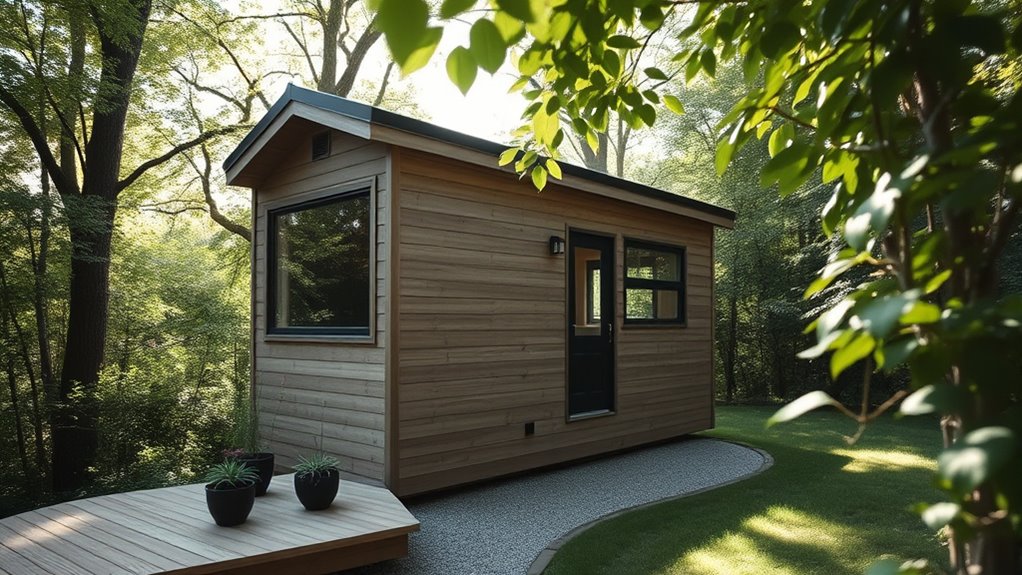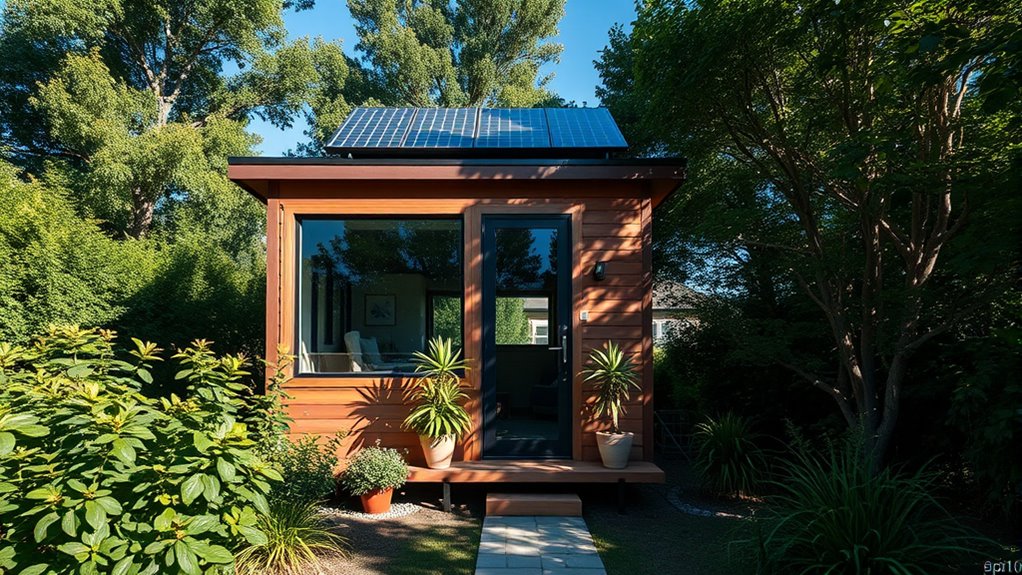The tiny house movement encourages you to downsize your living space, helping you reduce your ecological footprint and live more intentionally. By choosing a smaller home built with eco-friendly materials, you’ll use less energy and produce less waste. This lifestyle simplifies daily routines, lowers costs, and fosters a closer connection to nature. If you want to explore how tiny living can transform both your life and the planet, there’s much more to discover.
Key Takeaways
- The movement promotes living in smaller, eco-friendly homes to reduce environmental impact and lower energy consumption.
- Downsizing emphasizes simplicity, decluttering, and focusing on experiences over material possessions.
- Tiny houses often incorporate sustainable materials and energy-efficient systems like solar panels.
- Living tiny decreases carbon footprint, promotes self-sufficiency, and supports eco-conscious lifestyle choices.
- The movement challenges traditional housing norms, encouraging mindful, sustainable living for personal and planetary well-being.

Have you ever wondered if downsizing your living space could lead to a simpler, more sustainable lifestyle? The tiny house movement is gaining momentum for exactly that reason. More people are realizing they don’t need a sprawling home to live comfortably or happily. Instead, they’re embracing a minimalist lifestyle that emphasizes quality over quantity. This shift isn’t just about reducing clutter; it’s about intentionally designing a space that promotes sustainability and efficiency. Eco friendly design plays a central role here. Tiny houses are often built with environmentally conscious materials and incorporate energy-efficient systems, like solar panels and composting toilets, to minimize their ecological impact. By scaling down, you naturally cut your energy consumption and waste, making your footprint smaller without sacrificing comfort. Additionally, utilizing juice cleanses and detox principles can support your health as you transition to a simpler lifestyle. Choosing to live tiny encourages you to rethink what truly matters. Instead of accumulating possessions, you focus on experiences and relationships. This mindset aligns perfectly with the minimalist lifestyle, which advocates for intentional living—keeping only what adds value and joy. Downsizing forces you to declutter and prioritize, leading to a more organized, peaceful environment. It becomes easier to maintain and clean, freeing up time and energy for pursuits that enrich your life. Plus, a smaller space often means less maintenance and lower utility bills, easing financial stress and allowing you to allocate resources toward sustainable investments or passions. Building or buying a tiny home gives you the opportunity to incorporate eco friendly design principles from the ground up. You can choose sustainable materials like reclaimed wood or recycled steel, and install energy-saving appliances and insulation. Many tiny homes are designed to be off-grid, giving you the option to live completely self-sufficiently. This not only reduces your reliance on traditional utilities but also promotes a deeper connection with nature. The mobility of tiny houses adds another layer of sustainability—if you’re inclined, you can relocate to less crowded or more environmentally friendly areas, minimizing your ecological impact even further. Embracing the tiny house movement means adopting a lifestyle that values simplicity, sustainability, and intentionality. It challenges you to rethink your relationship with your possessions and your environment. With eco friendly design, you can considerably reduce your carbon footprint while enjoying the benefits of a cozy, manageable space. The shift to tiny living isn’t just about saving money or space; it’s about creating a life that’s more aligned with your values and the planet’s well-being. The change might be small in size, but it can lead to a big transformation in how you live, breathe, and connect with the world around you.
Frequently Asked Questions
How Do Tiny Houses Handle Storage and Organization?
You can handle storage and organization in tiny houses by using creative storage solutions that maximize small spaces. Think vertically with wall-mounted shelves, utilize multifunctional furniture like beds with built-in drawers, and incorporate hidden compartments. By carefully planning and choosing versatile furniture, you make the most of every inch, keeping your space tidy and functional. This approach guarantees your tiny house remains clutter-free while providing ample storage options.
What Are the Legal Zoning Restrictions for Tiny Houses?
Like a compass guiding your path, zoning ordinances and building codes shape where your tiny house can stand. You need to check local zoning restrictions, as some areas restrict tiny homes for permanent residence or require specific setbacks. Building codes ensure safety and compliance, but they can vary widely. Before you build, research your local regulations to avoid surprises, making sure your tiny house fits within the legal landscape.
How Do Tiny House Owners Finance Their Homes?
You might find it challenging to finance your tiny house due to limited financing options and mortgage challenges. Many owners use personal loans, savings, or seller financing to cover costs. Some seek specialized tiny house lenders or convert existing assets. Since traditional mortgages are often harder to secure, exploring alternative financing options becomes essential. Planning ahead and understanding your options can help you turn your tiny house dream into reality.
Can Tiny Houses Be Moved Easily Across Different Locations?
Did you know that about 50% of tiny house owners move their homes at least once? When it comes to transport mobility, tiny houses can be moved, but you’ll face relocation challenges like finding suitable roads and permits. Their size makes them more adaptable than traditional homes, but planning is essential to guarantee smooth transport across different locations. Proper preparation helps you enjoy the freedom of mobility without unnecessary hurdles.
What Are the Long-Term Maintenance Costs for Tiny Houses?
You should consider the long-term maintenance costs of tiny houses, which can vary. Cost estimation helps you plan for routine repairs and upgrades, while warranty coverage may shield you from unexpected expenses. Typically, these costs are lower than traditional homes, but factors like appliance lifespan and roof durability matter. Regular upkeep ensures your tiny house stays functional and efficient, saving you money over time.
Conclusion
As you step inside a tiny house, imagine the warm sunlight filtering through compact windows, illuminating every clever storage nook. With each carefully chosen piece, you’re creating a cozy haven that shrinks your footprint without sacrificing comfort. The movement invites you to embrace simplicity, where less clutter means more freedom. Picture yourself living intentionally, surrounded by open space and natural light—truly downsizing to find more joy in every corner of your smaller, greener world.










